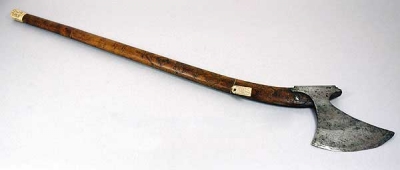Peasant's axe (1884.26.10)
 NorwayPeasant's axe from Norway, Europe. Part of the Pitt Rivers Museum Founding Collection. Given to the Museum in 1884.
NorwayPeasant's axe from Norway, Europe. Part of the Pitt Rivers Museum Founding Collection. Given to the Museum in 1884.
The curved shaft of this axe is distinctively Scandinavian. The axe is of great symbolic worth in Scandinavia, and appears on the royal crest of Norway as a symbol of Saint Olav, the country's patron saint.
The curved shape may have emerged from it being worn over the shoulder at the back or, more likely, from the fact that a blow with a back-curved blade has a larger contact area or 'point of percussion', reducing the need for absolute accuracy and increasing the chance of inflicting damage. This same principle applies to the curved swords of South Asia.
Curved axes such as this have been found in Denmark dating to the 10th Century AD, thus earning it the name of 'Viking-style' axe but this particular example is undoubtedly several centuries later. It would have belonged to an important or wealthy person as it is embellished with an ivory butt cap and the ash-wood haft is covered with incised surface decoration. The featured cartouches, scrolls and bands are reminiscent of a late-17th century decorative style, common to Norway, Denmark and Germany, that was applied to both wood and metalwork.





